Analysis of Information Systems and ERP Systems in Business
VerifiedAdded on 2020/10/23
|9
|2512
|61
Report
AI Summary
This report provides a comprehensive overview of information systems and Enterprise Resource Planning (ERP) systems. It begins by defining information systems and discussing their fundamental roles in supporting business operations, aiding decision-making, and enabling strategic advantages. The report then delves into various categories of information systems, including Transaction Processing Systems, Decision Support Systems, Management Information Systems, and Expert Systems. A significant portion is dedicated to ERP systems, explaining their functionality, characteristics, and benefits such as enhanced collaboration, improved reporting, increased productivity, flexibility, security, and efficiency. The report recommends the adoption of information technology and ERP systems to improve data management, collaboration, productivity, and overall business performance. The conclusion emphasizes the importance of aligning technology and business strategies for effective information technology management.
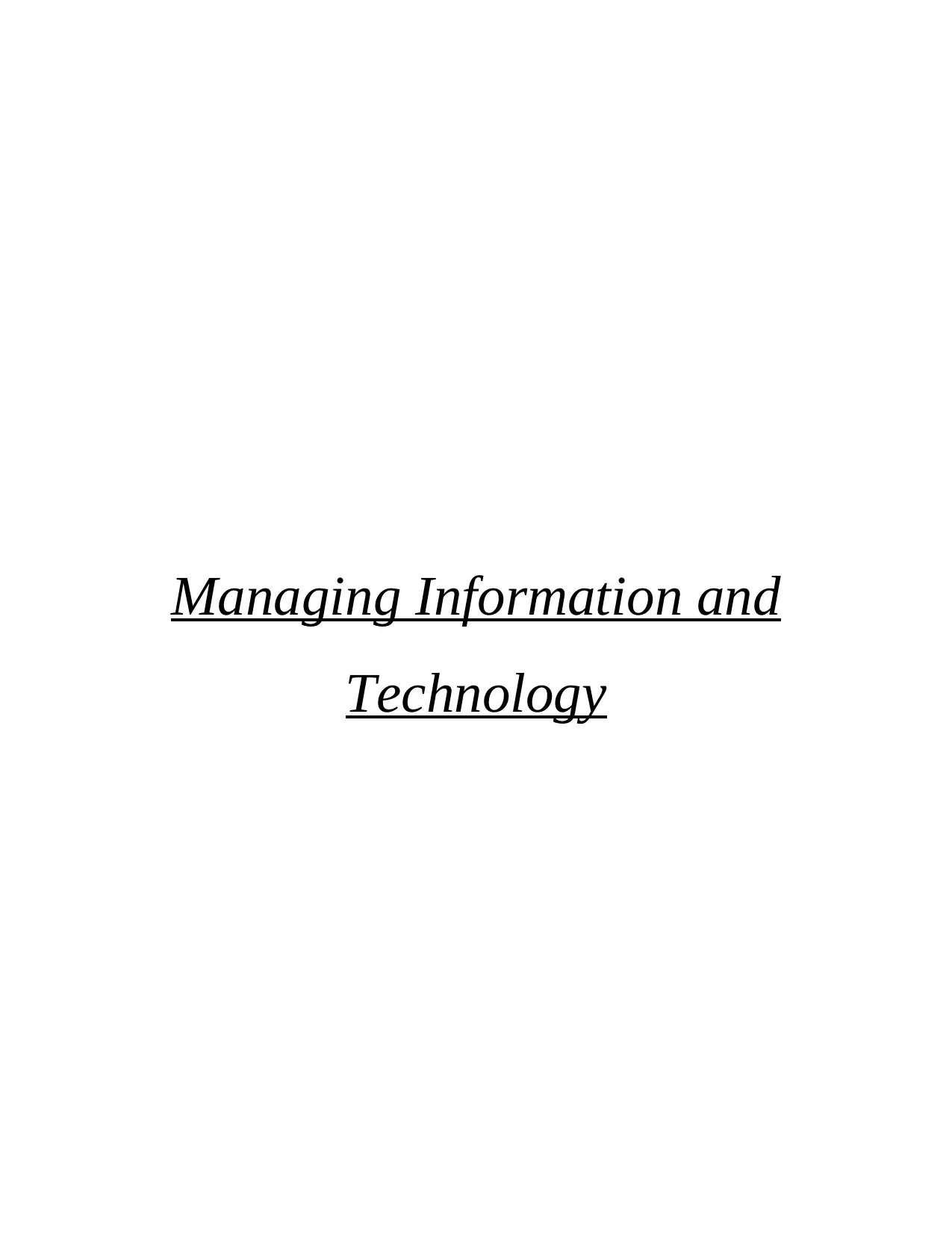
Managing Information and
Technology
Technology
Paraphrase This Document
Need a fresh take? Get an instant paraphrase of this document with our AI Paraphraser
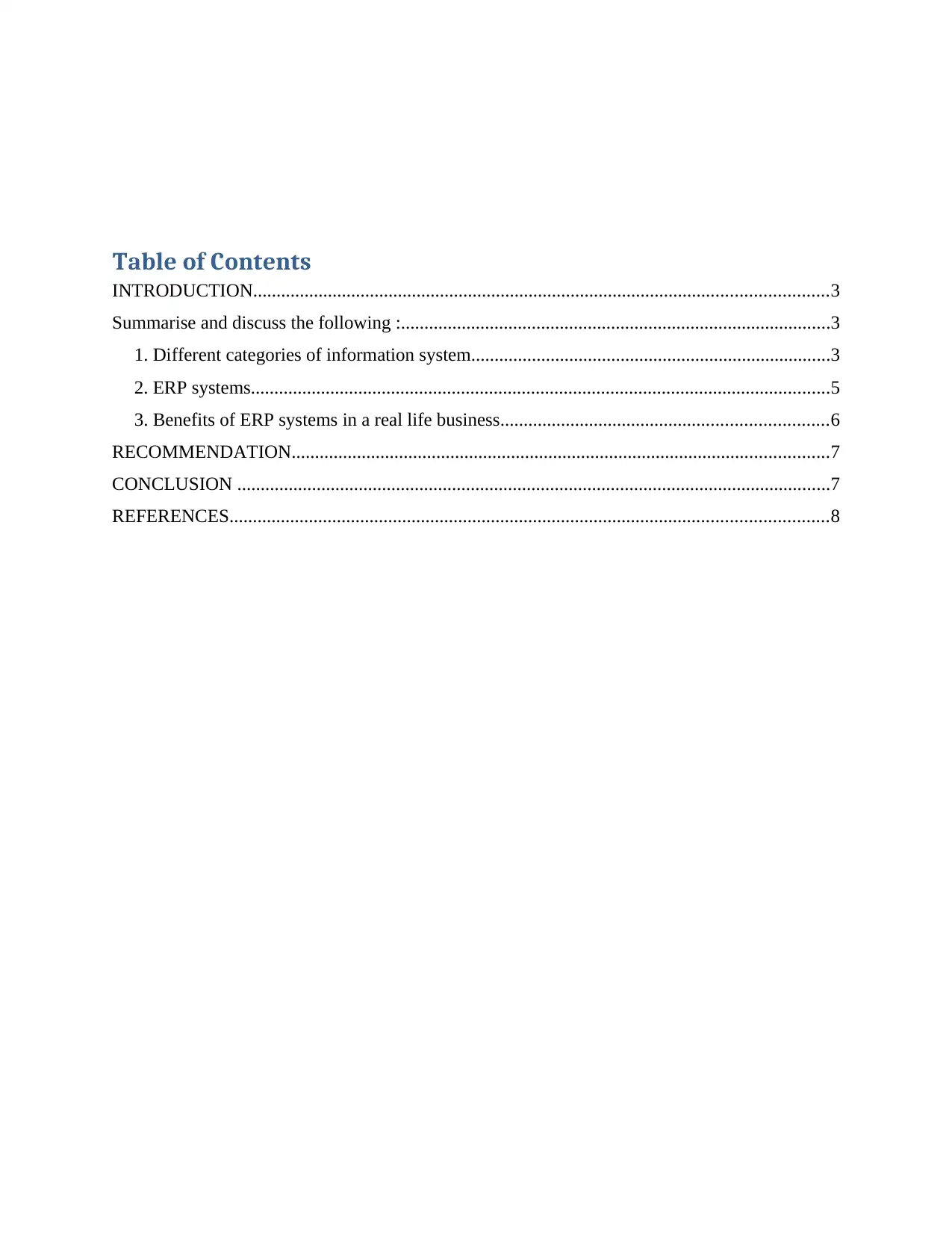
Table of Contents
INTRODUCTION...........................................................................................................................3
Summarise and discuss the following :............................................................................................3
1. Different categories of information system.............................................................................3
2. ERP systems............................................................................................................................5
3. Benefits of ERP systems in a real life business......................................................................6
RECOMMENDATION...................................................................................................................7
CONCLUSION ...............................................................................................................................7
REFERENCES................................................................................................................................8
INTRODUCTION...........................................................................................................................3
Summarise and discuss the following :............................................................................................3
1. Different categories of information system.............................................................................3
2. ERP systems............................................................................................................................5
3. Benefits of ERP systems in a real life business......................................................................6
RECOMMENDATION...................................................................................................................7
CONCLUSION ...............................................................................................................................7
REFERENCES................................................................................................................................8
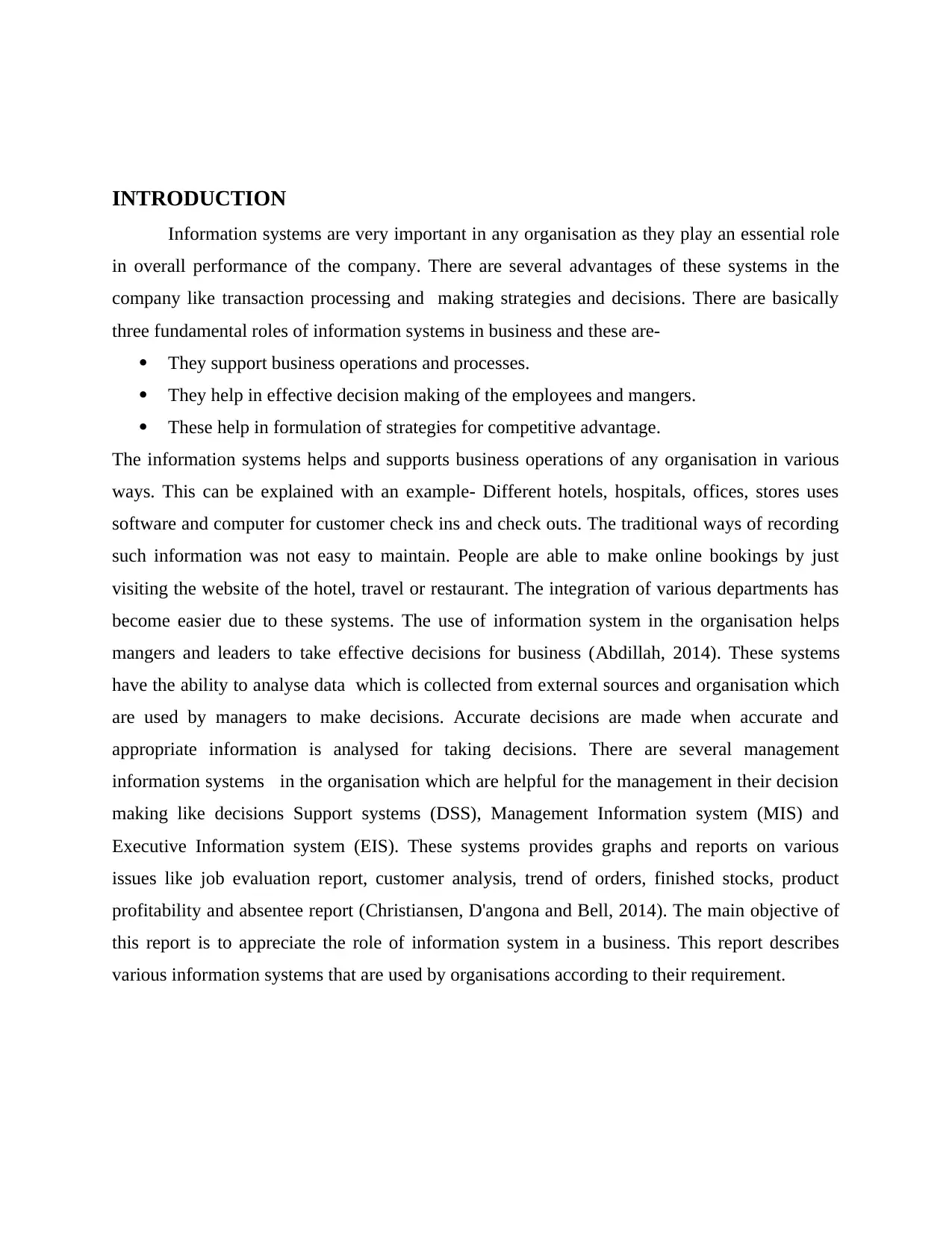
INTRODUCTION
Information systems are very important in any organisation as they play an essential role
in overall performance of the company. There are several advantages of these systems in the
company like transaction processing and making strategies and decisions. There are basically
three fundamental roles of information systems in business and these are-
They support business operations and processes.
They help in effective decision making of the employees and mangers.
These help in formulation of strategies for competitive advantage.
The information systems helps and supports business operations of any organisation in various
ways. This can be explained with an example- Different hotels, hospitals, offices, stores uses
software and computer for customer check ins and check outs. The traditional ways of recording
such information was not easy to maintain. People are able to make online bookings by just
visiting the website of the hotel, travel or restaurant. The integration of various departments has
become easier due to these systems. The use of information system in the organisation helps
mangers and leaders to take effective decisions for business (Abdillah, 2014). These systems
have the ability to analyse data which is collected from external sources and organisation which
are used by managers to make decisions. Accurate decisions are made when accurate and
appropriate information is analysed for taking decisions. There are several management
information systems in the organisation which are helpful for the management in their decision
making like decisions Support systems (DSS), Management Information system (MIS) and
Executive Information system (EIS). These systems provides graphs and reports on various
issues like job evaluation report, customer analysis, trend of orders, finished stocks, product
profitability and absentee report (Christiansen, D'angona and Bell, 2014). The main objective of
this report is to appreciate the role of information system in a business. This report describes
various information systems that are used by organisations according to their requirement.
Information systems are very important in any organisation as they play an essential role
in overall performance of the company. There are several advantages of these systems in the
company like transaction processing and making strategies and decisions. There are basically
three fundamental roles of information systems in business and these are-
They support business operations and processes.
They help in effective decision making of the employees and mangers.
These help in formulation of strategies for competitive advantage.
The information systems helps and supports business operations of any organisation in various
ways. This can be explained with an example- Different hotels, hospitals, offices, stores uses
software and computer for customer check ins and check outs. The traditional ways of recording
such information was not easy to maintain. People are able to make online bookings by just
visiting the website of the hotel, travel or restaurant. The integration of various departments has
become easier due to these systems. The use of information system in the organisation helps
mangers and leaders to take effective decisions for business (Abdillah, 2014). These systems
have the ability to analyse data which is collected from external sources and organisation which
are used by managers to make decisions. Accurate decisions are made when accurate and
appropriate information is analysed for taking decisions. There are several management
information systems in the organisation which are helpful for the management in their decision
making like decisions Support systems (DSS), Management Information system (MIS) and
Executive Information system (EIS). These systems provides graphs and reports on various
issues like job evaluation report, customer analysis, trend of orders, finished stocks, product
profitability and absentee report (Christiansen, D'angona and Bell, 2014). The main objective of
this report is to appreciate the role of information system in a business. This report describes
various information systems that are used by organisations according to their requirement.
⊘ This is a preview!⊘
Do you want full access?
Subscribe today to unlock all pages.

Trusted by 1+ million students worldwide
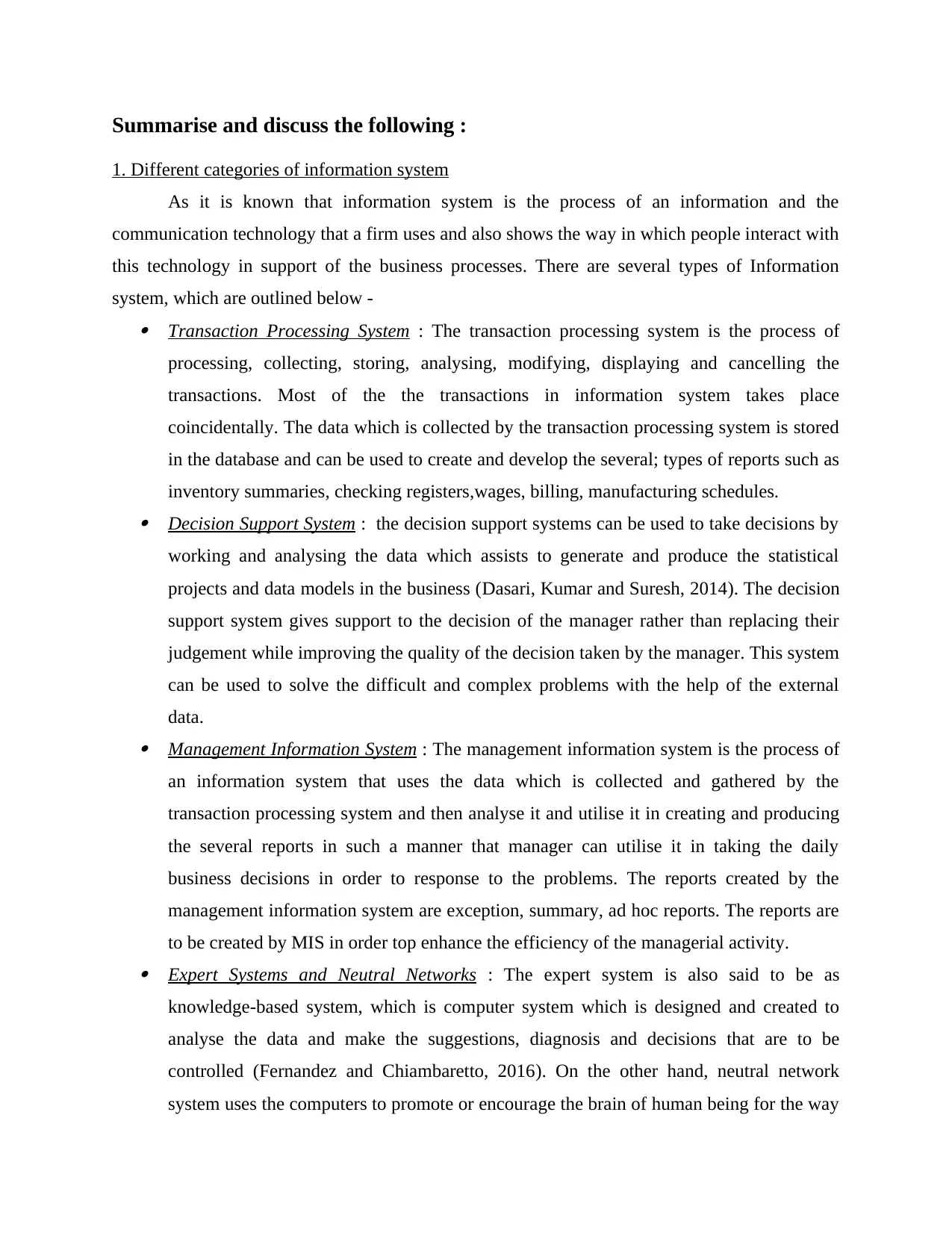
Summarise and discuss the following :
1. Different categories of information system
As it is known that information system is the process of an information and the
communication technology that a firm uses and also shows the way in which people interact with
this technology in support of the business processes. There are several types of Information
system, which are outlined below - Transaction Processing System : The transaction processing system is the process of
processing, collecting, storing, analysing, modifying, displaying and cancelling the
transactions. Most of the the transactions in information system takes place
coincidentally. The data which is collected by the transaction processing system is stored
in the database and can be used to create and develop the several; types of reports such as
inventory summaries, checking registers,wages, billing, manufacturing schedules. Decision Support System : the decision support systems can be used to take decisions by
working and analysing the data which assists to generate and produce the statistical
projects and data models in the business (Dasari, Kumar and Suresh, 2014). The decision
support system gives support to the decision of the manager rather than replacing their
judgement while improving the quality of the decision taken by the manager. This system
can be used to solve the difficult and complex problems with the help of the external
data. Management Information System : The management information system is the process of
an information system that uses the data which is collected and gathered by the
transaction processing system and then analyse it and utilise it in creating and producing
the several reports in such a manner that manager can utilise it in taking the daily
business decisions in order to response to the problems. The reports created by the
management information system are exception, summary, ad hoc reports. The reports are
to be created by MIS in order top enhance the efficiency of the managerial activity. Expert Systems and Neutral Networks : The expert system is also said to be as
knowledge-based system, which is computer system which is designed and created to
analyse the data and make the suggestions, diagnosis and decisions that are to be
controlled (Fernandez and Chiambaretto, 2016). On the other hand, neutral network
system uses the computers to promote or encourage the brain of human being for the way
1. Different categories of information system
As it is known that information system is the process of an information and the
communication technology that a firm uses and also shows the way in which people interact with
this technology in support of the business processes. There are several types of Information
system, which are outlined below - Transaction Processing System : The transaction processing system is the process of
processing, collecting, storing, analysing, modifying, displaying and cancelling the
transactions. Most of the the transactions in information system takes place
coincidentally. The data which is collected by the transaction processing system is stored
in the database and can be used to create and develop the several; types of reports such as
inventory summaries, checking registers,wages, billing, manufacturing schedules. Decision Support System : the decision support systems can be used to take decisions by
working and analysing the data which assists to generate and produce the statistical
projects and data models in the business (Dasari, Kumar and Suresh, 2014). The decision
support system gives support to the decision of the manager rather than replacing their
judgement while improving the quality of the decision taken by the manager. This system
can be used to solve the difficult and complex problems with the help of the external
data. Management Information System : The management information system is the process of
an information system that uses the data which is collected and gathered by the
transaction processing system and then analyse it and utilise it in creating and producing
the several reports in such a manner that manager can utilise it in taking the daily
business decisions in order to response to the problems. The reports created by the
management information system are exception, summary, ad hoc reports. The reports are
to be created by MIS in order top enhance the efficiency of the managerial activity. Expert Systems and Neutral Networks : The expert system is also said to be as
knowledge-based system, which is computer system which is designed and created to
analyse the data and make the suggestions, diagnosis and decisions that are to be
controlled (Fernandez and Chiambaretto, 2016). On the other hand, neutral network
system uses the computers to promote or encourage the brain of human being for the way
Paraphrase This Document
Need a fresh take? Get an instant paraphrase of this document with our AI Paraphraser
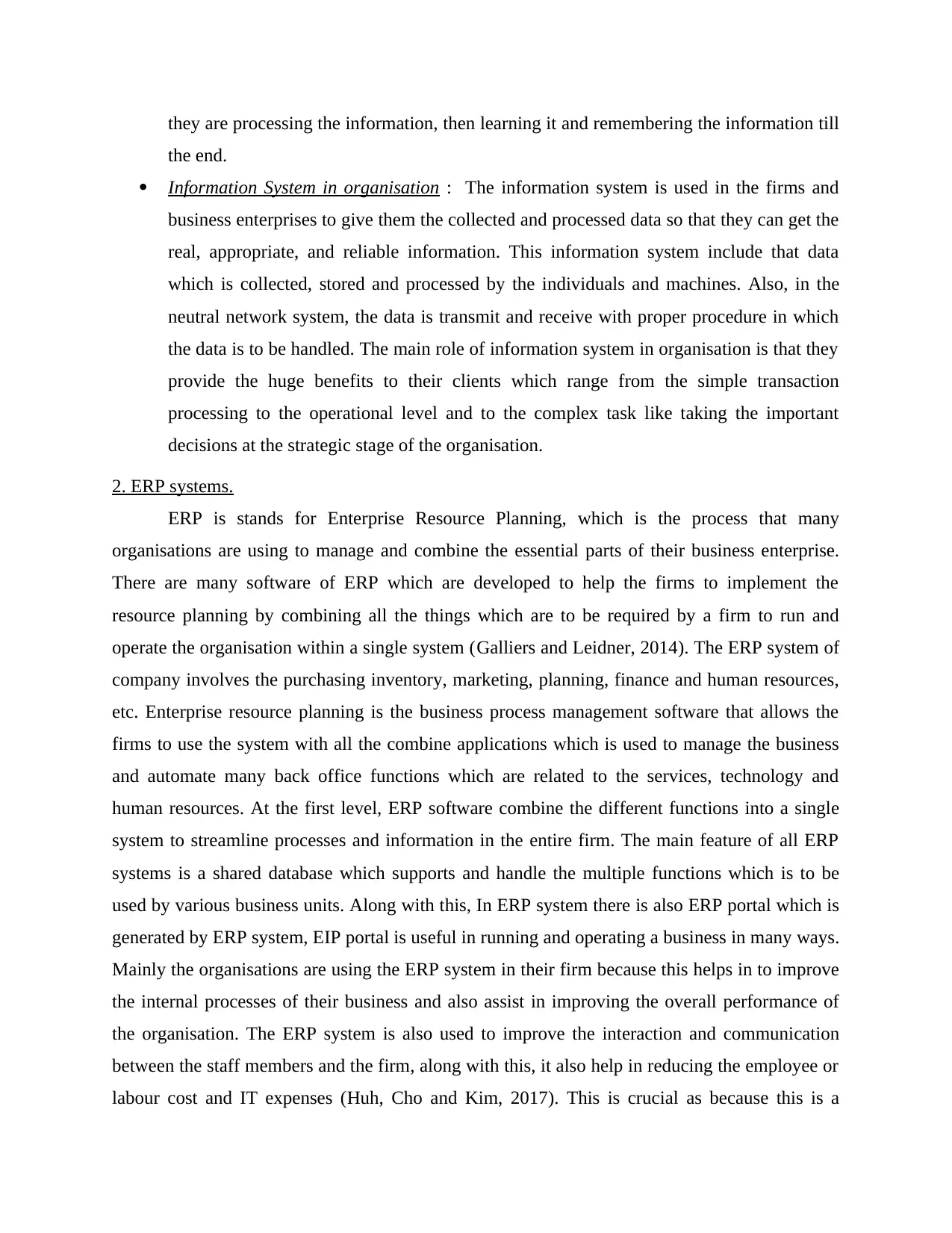
they are processing the information, then learning it and remembering the information till
the end.
Information System in organisation : The information system is used in the firms and
business enterprises to give them the collected and processed data so that they can get the
real, appropriate, and reliable information. This information system include that data
which is collected, stored and processed by the individuals and machines. Also, in the
neutral network system, the data is transmit and receive with proper procedure in which
the data is to be handled. The main role of information system in organisation is that they
provide the huge benefits to their clients which range from the simple transaction
processing to the operational level and to the complex task like taking the important
decisions at the strategic stage of the organisation.
2. ERP systems.
ERP is stands for Enterprise Resource Planning, which is the process that many
organisations are using to manage and combine the essential parts of their business enterprise.
There are many software of ERP which are developed to help the firms to implement the
resource planning by combining all the things which are to be required by a firm to run and
operate the organisation within a single system (Galliers and Leidner, 2014). The ERP system of
company involves the purchasing inventory, marketing, planning, finance and human resources,
etc. Enterprise resource planning is the business process management software that allows the
firms to use the system with all the combine applications which is used to manage the business
and automate many back office functions which are related to the services, technology and
human resources. At the first level, ERP software combine the different functions into a single
system to streamline processes and information in the entire firm. The main feature of all ERP
systems is a shared database which supports and handle the multiple functions which is to be
used by various business units. Along with this, In ERP system there is also ERP portal which is
generated by ERP system, EIP portal is useful in running and operating a business in many ways.
Mainly the organisations are using the ERP system in their firm because this helps in to improve
the internal processes of their business and also assist in improving the overall performance of
the organisation. The ERP system is also used to improve the interaction and communication
between the staff members and the firm, along with this, it also help in reducing the employee or
labour cost and IT expenses (Huh, Cho and Kim, 2017). This is crucial as because this is a
the end.
Information System in organisation : The information system is used in the firms and
business enterprises to give them the collected and processed data so that they can get the
real, appropriate, and reliable information. This information system include that data
which is collected, stored and processed by the individuals and machines. Also, in the
neutral network system, the data is transmit and receive with proper procedure in which
the data is to be handled. The main role of information system in organisation is that they
provide the huge benefits to their clients which range from the simple transaction
processing to the operational level and to the complex task like taking the important
decisions at the strategic stage of the organisation.
2. ERP systems.
ERP is stands for Enterprise Resource Planning, which is the process that many
organisations are using to manage and combine the essential parts of their business enterprise.
There are many software of ERP which are developed to help the firms to implement the
resource planning by combining all the things which are to be required by a firm to run and
operate the organisation within a single system (Galliers and Leidner, 2014). The ERP system of
company involves the purchasing inventory, marketing, planning, finance and human resources,
etc. Enterprise resource planning is the business process management software that allows the
firms to use the system with all the combine applications which is used to manage the business
and automate many back office functions which are related to the services, technology and
human resources. At the first level, ERP software combine the different functions into a single
system to streamline processes and information in the entire firm. The main feature of all ERP
systems is a shared database which supports and handle the multiple functions which is to be
used by various business units. Along with this, In ERP system there is also ERP portal which is
generated by ERP system, EIP portal is useful in running and operating a business in many ways.
Mainly the organisations are using the ERP system in their firm because this helps in to improve
the internal processes of their business and also assist in improving the overall performance of
the organisation. The ERP system is also used to improve the interaction and communication
between the staff members and the firm, along with this, it also help in reducing the employee or
labour cost and IT expenses (Huh, Cho and Kim, 2017). This is crucial as because this is a
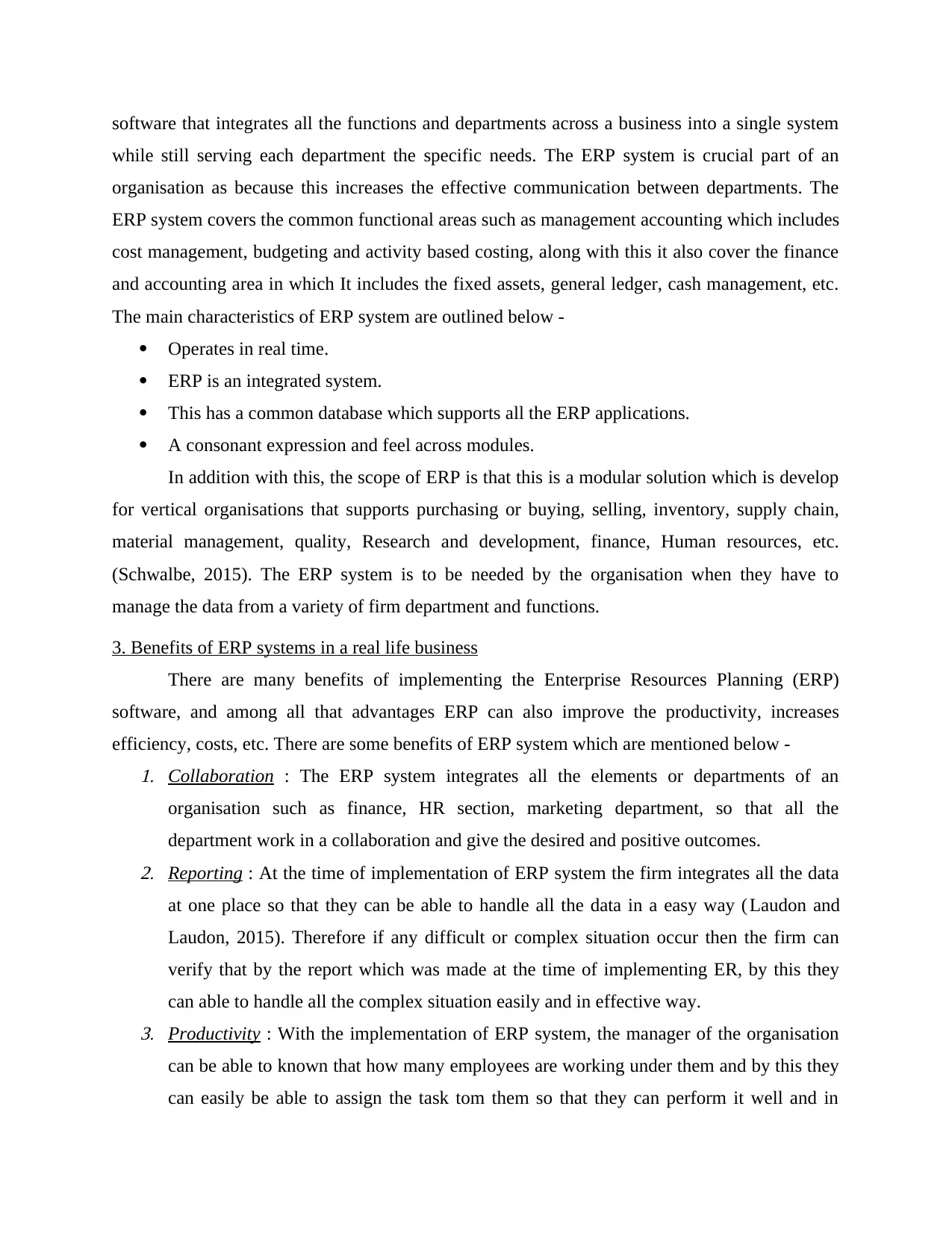
software that integrates all the functions and departments across a business into a single system
while still serving each department the specific needs. The ERP system is crucial part of an
organisation as because this increases the effective communication between departments. The
ERP system covers the common functional areas such as management accounting which includes
cost management, budgeting and activity based costing, along with this it also cover the finance
and accounting area in which It includes the fixed assets, general ledger, cash management, etc.
The main characteristics of ERP system are outlined below -
Operates in real time.
ERP is an integrated system.
This has a common database which supports all the ERP applications.
A consonant expression and feel across modules.
In addition with this, the scope of ERP is that this is a modular solution which is develop
for vertical organisations that supports purchasing or buying, selling, inventory, supply chain,
material management, quality, Research and development, finance, Human resources, etc.
(Schwalbe, 2015). The ERP system is to be needed by the organisation when they have to
manage the data from a variety of firm department and functions.
3. Benefits of ERP systems in a real life business
There are many benefits of implementing the Enterprise Resources Planning (ERP)
software, and among all that advantages ERP can also improve the productivity, increases
efficiency, costs, etc. There are some benefits of ERP system which are mentioned below -1. Collaboration : The ERP system integrates all the elements or departments of an
organisation such as finance, HR section, marketing department, so that all the
department work in a collaboration and give the desired and positive outcomes.2. Reporting : At the time of implementation of ERP system the firm integrates all the data
at one place so that they can be able to handle all the data in a easy way ( Laudon and
Laudon, 2015). Therefore if any difficult or complex situation occur then the firm can
verify that by the report which was made at the time of implementing ER, by this they
can able to handle all the complex situation easily and in effective way.3. Productivity : With the implementation of ERP system, the manager of the organisation
can be able to known that how many employees are working under them and by this they
can easily be able to assign the task tom them so that they can perform it well and in
while still serving each department the specific needs. The ERP system is crucial part of an
organisation as because this increases the effective communication between departments. The
ERP system covers the common functional areas such as management accounting which includes
cost management, budgeting and activity based costing, along with this it also cover the finance
and accounting area in which It includes the fixed assets, general ledger, cash management, etc.
The main characteristics of ERP system are outlined below -
Operates in real time.
ERP is an integrated system.
This has a common database which supports all the ERP applications.
A consonant expression and feel across modules.
In addition with this, the scope of ERP is that this is a modular solution which is develop
for vertical organisations that supports purchasing or buying, selling, inventory, supply chain,
material management, quality, Research and development, finance, Human resources, etc.
(Schwalbe, 2015). The ERP system is to be needed by the organisation when they have to
manage the data from a variety of firm department and functions.
3. Benefits of ERP systems in a real life business
There are many benefits of implementing the Enterprise Resources Planning (ERP)
software, and among all that advantages ERP can also improve the productivity, increases
efficiency, costs, etc. There are some benefits of ERP system which are mentioned below -1. Collaboration : The ERP system integrates all the elements or departments of an
organisation such as finance, HR section, marketing department, so that all the
department work in a collaboration and give the desired and positive outcomes.2. Reporting : At the time of implementation of ERP system the firm integrates all the data
at one place so that they can be able to handle all the data in a easy way ( Laudon and
Laudon, 2015). Therefore if any difficult or complex situation occur then the firm can
verify that by the report which was made at the time of implementing ER, by this they
can able to handle all the complex situation easily and in effective way.3. Productivity : With the implementation of ERP system, the manager of the organisation
can be able to known that how many employees are working under them and by this they
can easily be able to assign the task tom them so that they can perform it well and in
⊘ This is a preview!⊘
Do you want full access?
Subscribe today to unlock all pages.

Trusted by 1+ million students worldwide
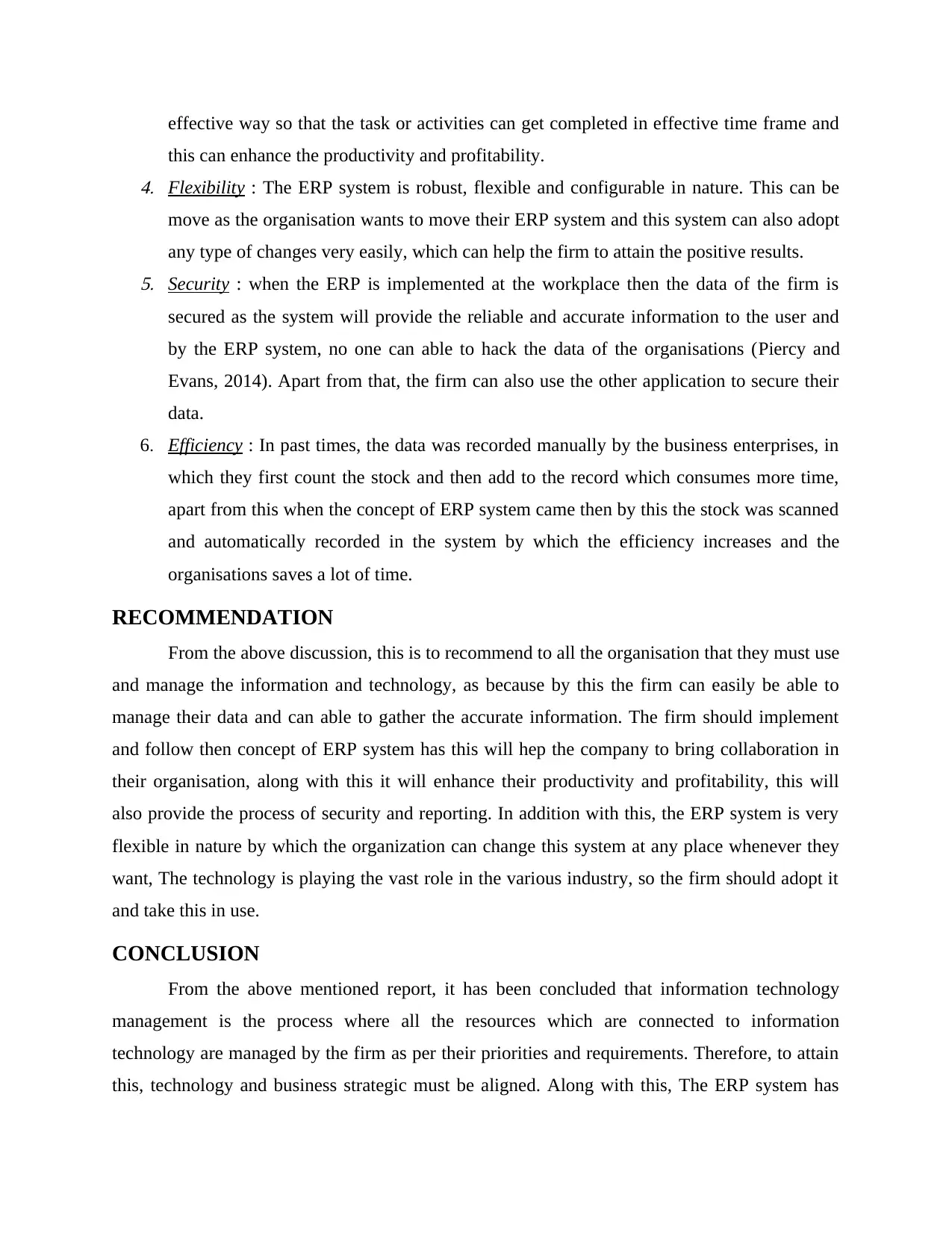
effective way so that the task or activities can get completed in effective time frame and
this can enhance the productivity and profitability.4. Flexibility : The ERP system is robust, flexible and configurable in nature. This can be
move as the organisation wants to move their ERP system and this system can also adopt
any type of changes very easily, which can help the firm to attain the positive results.5. Security : when the ERP is implemented at the workplace then the data of the firm is
secured as the system will provide the reliable and accurate information to the user and
by the ERP system, no one can able to hack the data of the organisations (Piercy and
Evans, 2014). Apart from that, the firm can also use the other application to secure their
data.
6. Efficiency : In past times, the data was recorded manually by the business enterprises, in
which they first count the stock and then add to the record which consumes more time,
apart from this when the concept of ERP system came then by this the stock was scanned
and automatically recorded in the system by which the efficiency increases and the
organisations saves a lot of time.
RECOMMENDATION
From the above discussion, this is to recommend to all the organisation that they must use
and manage the information and technology, as because by this the firm can easily be able to
manage their data and can able to gather the accurate information. The firm should implement
and follow then concept of ERP system has this will hep the company to bring collaboration in
their organisation, along with this it will enhance their productivity and profitability, this will
also provide the process of security and reporting. In addition with this, the ERP system is very
flexible in nature by which the organization can change this system at any place whenever they
want, The technology is playing the vast role in the various industry, so the firm should adopt it
and take this in use.
CONCLUSION
From the above mentioned report, it has been concluded that information technology
management is the process where all the resources which are connected to information
technology are managed by the firm as per their priorities and requirements. Therefore, to attain
this, technology and business strategic must be aligned. Along with this, The ERP system has
this can enhance the productivity and profitability.4. Flexibility : The ERP system is robust, flexible and configurable in nature. This can be
move as the organisation wants to move their ERP system and this system can also adopt
any type of changes very easily, which can help the firm to attain the positive results.5. Security : when the ERP is implemented at the workplace then the data of the firm is
secured as the system will provide the reliable and accurate information to the user and
by the ERP system, no one can able to hack the data of the organisations (Piercy and
Evans, 2014). Apart from that, the firm can also use the other application to secure their
data.
6. Efficiency : In past times, the data was recorded manually by the business enterprises, in
which they first count the stock and then add to the record which consumes more time,
apart from this when the concept of ERP system came then by this the stock was scanned
and automatically recorded in the system by which the efficiency increases and the
organisations saves a lot of time.
RECOMMENDATION
From the above discussion, this is to recommend to all the organisation that they must use
and manage the information and technology, as because by this the firm can easily be able to
manage their data and can able to gather the accurate information. The firm should implement
and follow then concept of ERP system has this will hep the company to bring collaboration in
their organisation, along with this it will enhance their productivity and profitability, this will
also provide the process of security and reporting. In addition with this, the ERP system is very
flexible in nature by which the organization can change this system at any place whenever they
want, The technology is playing the vast role in the various industry, so the firm should adopt it
and take this in use.
CONCLUSION
From the above mentioned report, it has been concluded that information technology
management is the process where all the resources which are connected to information
technology are managed by the firm as per their priorities and requirements. Therefore, to attain
this, technology and business strategic must be aligned. Along with this, The ERP system has
Paraphrase This Document
Need a fresh take? Get an instant paraphrase of this document with our AI Paraphraser

been discussed in the above report along with their benefits in a real business, which help an
organisation to enhance the productivity, provide flexibility, security, etc. The organisation must
follow the concept of information technology as this will help the firm to accomplish their
desired business goals in effective time frame.
organisation to enhance the productivity, provide flexibility, security, etc. The organisation must
follow the concept of information technology as this will help the firm to accomplish their
desired business goals in effective time frame.
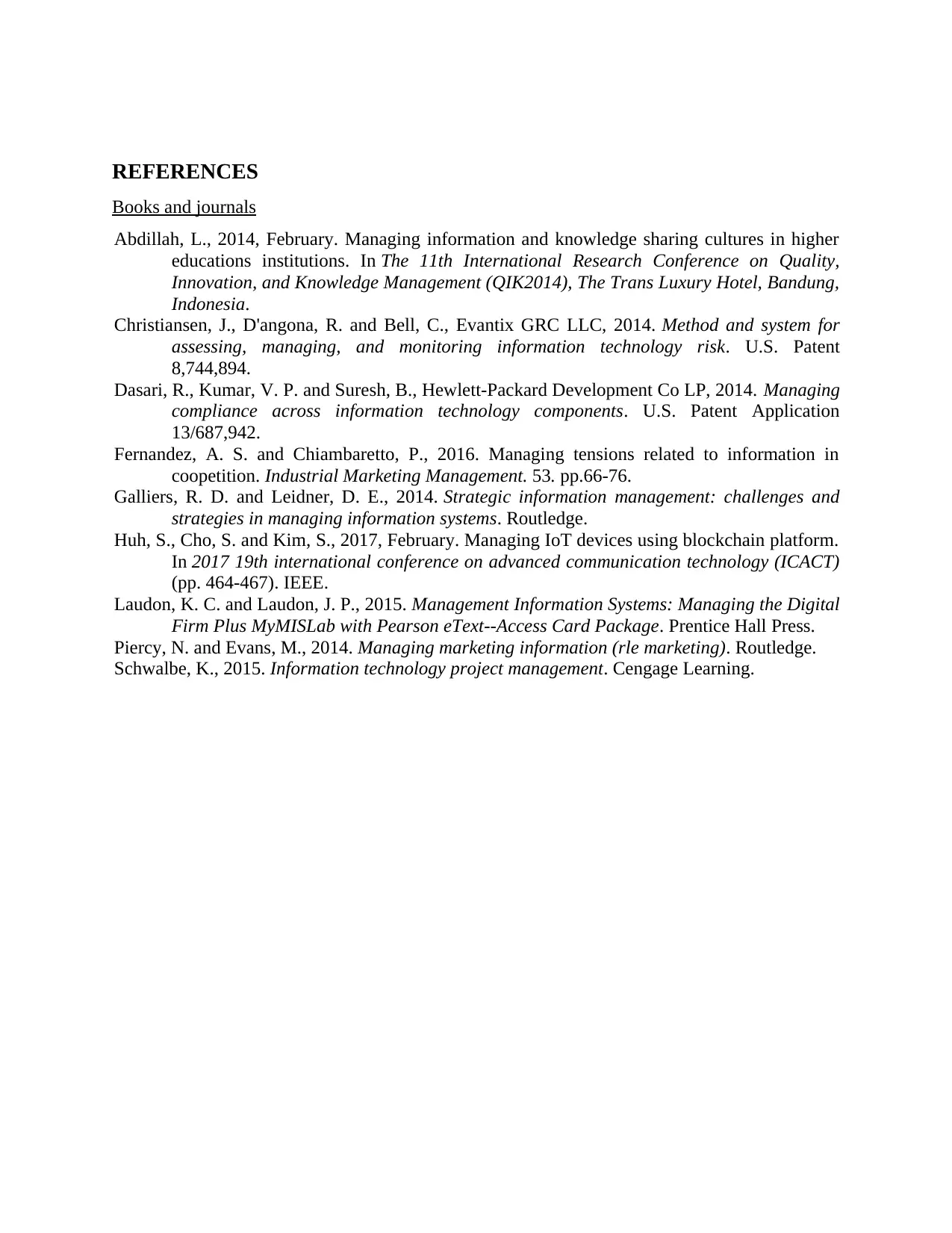
REFERENCES
Books and journals
Abdillah, L., 2014, February. Managing information and knowledge sharing cultures in higher
educations institutions. In The 11th International Research Conference on Quality,
Innovation, and Knowledge Management (QIK2014), The Trans Luxury Hotel, Bandung,
Indonesia.
Christiansen, J., D'angona, R. and Bell, C., Evantix GRC LLC, 2014. Method and system for
assessing, managing, and monitoring information technology risk. U.S. Patent
8,744,894.
Dasari, R., Kumar, V. P. and Suresh, B., Hewlett-Packard Development Co LP, 2014. Managing
compliance across information technology components. U.S. Patent Application
13/687,942.
Fernandez, A. S. and Chiambaretto, P., 2016. Managing tensions related to information in
coopetition. Industrial Marketing Management. 53. pp.66-76.
Galliers, R. D. and Leidner, D. E., 2014. Strategic information management: challenges and
strategies in managing information systems. Routledge.
Huh, S., Cho, S. and Kim, S., 2017, February. Managing IoT devices using blockchain platform.
In 2017 19th international conference on advanced communication technology (ICACT)
(pp. 464-467). IEEE.
Laudon, K. C. and Laudon, J. P., 2015. Management Information Systems: Managing the Digital
Firm Plus MyMISLab with Pearson eText--Access Card Package. Prentice Hall Press.
Piercy, N. and Evans, M., 2014. Managing marketing information (rle marketing). Routledge.
Schwalbe, K., 2015. Information technology project management. Cengage Learning.
Books and journals
Abdillah, L., 2014, February. Managing information and knowledge sharing cultures in higher
educations institutions. In The 11th International Research Conference on Quality,
Innovation, and Knowledge Management (QIK2014), The Trans Luxury Hotel, Bandung,
Indonesia.
Christiansen, J., D'angona, R. and Bell, C., Evantix GRC LLC, 2014. Method and system for
assessing, managing, and monitoring information technology risk. U.S. Patent
8,744,894.
Dasari, R., Kumar, V. P. and Suresh, B., Hewlett-Packard Development Co LP, 2014. Managing
compliance across information technology components. U.S. Patent Application
13/687,942.
Fernandez, A. S. and Chiambaretto, P., 2016. Managing tensions related to information in
coopetition. Industrial Marketing Management. 53. pp.66-76.
Galliers, R. D. and Leidner, D. E., 2014. Strategic information management: challenges and
strategies in managing information systems. Routledge.
Huh, S., Cho, S. and Kim, S., 2017, February. Managing IoT devices using blockchain platform.
In 2017 19th international conference on advanced communication technology (ICACT)
(pp. 464-467). IEEE.
Laudon, K. C. and Laudon, J. P., 2015. Management Information Systems: Managing the Digital
Firm Plus MyMISLab with Pearson eText--Access Card Package. Prentice Hall Press.
Piercy, N. and Evans, M., 2014. Managing marketing information (rle marketing). Routledge.
Schwalbe, K., 2015. Information technology project management. Cengage Learning.
⊘ This is a preview!⊘
Do you want full access?
Subscribe today to unlock all pages.

Trusted by 1+ million students worldwide
1 out of 9
Related Documents
Your All-in-One AI-Powered Toolkit for Academic Success.
+13062052269
info@desklib.com
Available 24*7 on WhatsApp / Email
![[object Object]](/_next/static/media/star-bottom.7253800d.svg)
Unlock your academic potential
Copyright © 2020–2025 A2Z Services. All Rights Reserved. Developed and managed by ZUCOL.




